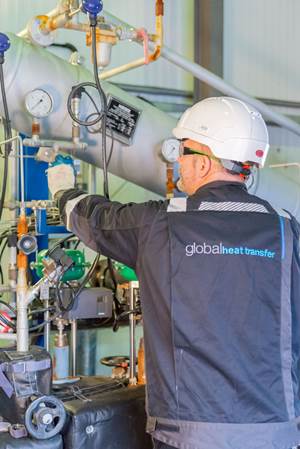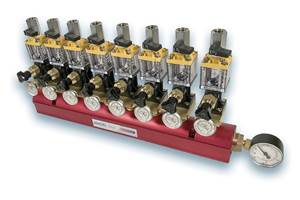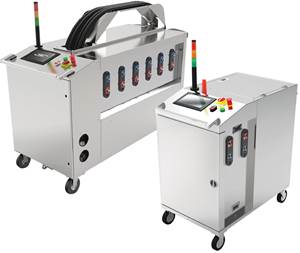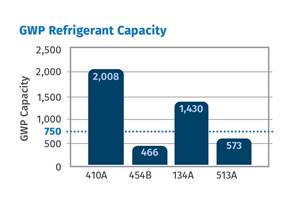How to Address Cooling System Woes
Anyone who operates a molding plant knows three things it cannot run without: raw material, electrical power, and cooling water.
Anyone who operates a molding plant knows three things it cannot run without: raw material, electrical power, and cooling water. The plant's machines cannot run steadily or efficiently without a well-functioning water system. But water-cooling systems are fairly complex and prone to many ills and failures. Some are acute and obvious, and some are more silent, creeping failures that slowly erode your plant's productivity.
Catastrophic failures
Abrupt cooling failures are often easiest to diagnose, but not necessarily so. The causes usually relate to issues of system design, equipment selection, or maintenance.
Flow failures are related to the water quality, system design, and pump configuration. Water quality is compromised by biological, chemical, and particulate contaminants introduced by the tower air and by minerals introduced by make-up water. The primary maintenance issue with pumps is seal replacement necessitated by water-quality problems. Prudent system design includes provision for back-up pumping—preferably a pump scheme that permits automatic transfer to the back-up pump to keep the system operating when a failure occurs. One solution is a "dual-arm" pump that incorporates two pumps in one casing.
It is also important to have a comprehensive understanding of the cooling system design. Often, the system fails because a valve operates incorrectly. It either opens when it shouldn't, or it may open too far, or not far enough. A valve may operate accidentally or even fail internally. Regardless, you will need to have a complete system drawing with valves and components identified and their locations noted for quick reference.
Water-quality problems can cause clogged filters and foul heat-transfer surfaces. Filters should be checked regularly or equipped with alarms to indicate cleanliness.
The most exciting flow problem is a burst pipe. If a main header bursts, the system can empty quickly, inundating operators and equipment. The failure is easy to see. It is normally much harder to identify the cause. Most often it is lack of proper support, such as a hanger failure. All piping must be supported to minimize stress. In addition, some pipe materials are more susceptible to failure than others. Welded steel lines are stronger and more resistant to fatigue from "water hammer" (transient pressure spikes) than plastic lines. However, steel corrodes and plastic doesn't. The answer to this dilemma is to operate your system with procedures that prevent water hammer.
Chiller failures are usually related to the condenser. One of the most common air condenser problems is a fan failure. If unit is air condensed, the air stream may be blocked by the location of the condenser. Or perhaps an air filter is clogged or the wafer-thin coil fins are bent over from rough handling.
Water condensers can fail when there is insufficient water flow to remove the heat from the refrigerant. The cause is often a leak or blockage of the condenser water supply—possibly by a malfunctioning valve—or else the condensing water may be too warm.
In either case, the "High Pressure" safety switch will be actuated. The cause must be corrected before you manually reset the switch.
A "Low Pressure" refrigerant alarm is an indication that the compressor does not have sufficient gas available to compress into the condenser. There are various possible causes but usually the problem is a refrigerant leak. In any event, low refrigerant pressure will require a qualified technician to locate and repair the problem. "Low Pressure" alarms can reset automatically without operator action, making it likely that the alarm will recur when operation continues.
Chiller compressor failure is rare but can be predicted by observing the system's operation. Frequent on/off cycling of the compressor usually precedes failure. The true cause may not be the compressor but the control system or other system components. This problem will require professional technical assistance. Note that a low load or a chiller too large for the application can lead to premature compressor failure from frequent on/off cycling.
Tower failures are mostly related to the fan drive and bearings. Proper maintenance requires per iodic inspection, belt tensioning, and bearing lubrication. Other tower failure modes are related to water flow. The incoming warm water is usually directed into the "fill" of the tower by flow nozzles. They can become clogged or dislodged. It is important to recognize that the tower internal element, the "fill," cannot withstand contact with hot water. A water temperature over 140 F will require a special design. Otherwise, you could cause catastrophic failure of the "fill" very quickly.
Tower water chemistry is critical to long-term reliability. Use a certified water-conditioning service to maintain your water quality.
Performance failures
Catastrophic system failures are easy to recognize and the corrective measures are relatively predictable and straightforward. More frustrating cooling-system woes occur when the process performance degrades gradually due to less-obvious cooling-system issues. It is imperative to be prepared with proper diagnostic tools before the inevitable problems occur.
It is a good policy to have a cooling system review and consultation before failures occur. The system troubleshooter must have a comprehensive knowledge of the cooling system. Some system suppliers offer engineering services such as engineering drawings of the cooling system (see accompanying example), as well as employee training and operating instructions.
Undersized or oversized system components often cause or exacerbate problems. The system load needs to be tabulated to ascertain its cooling-capacity limits. A "load study" can be performed to calculate the heat loads associated with each molding machine in the plant. Some processors find it valuable to keep periodic records of key system parameters for trend analysis and scheduling predictive maintenance.
Maintaining water quality is the best preventive measure you can take. Any contaminants in the water will degrade the cooling surfaces and reduce the heat capacity of the system. Reducing the oxygen content helps to reduce corrosion of metal surfaces. Proper water chemistry control and additives will also reduce the frequency of maintenance of heat-transfer surfaces. Strainers and filters can be used to reduce the suspended particle contamination in the water system and prevent potential damage to other components such as temperature controllers. Draining off "old" water and feeding in fresh make-up water will help reduce the mineral composition of the circulating fluid.
Jim Horne is systems project manager for Wittmann, Inc. in Torrington, Conn. He has more than 25 years of experience in plastics. He can be reached at (860)496-9603 or e-mail jhorne@wittmann-ct.com
Related Content
Follow These Best Practices When Working With Heat Transfer Fluids
Effectively choosing, operating and maintaining thermal fluid can positively impact productivity in plastics processing.
Read MoreIs Your Water System Setup Helping or Hurting Your Molding Plant Productivity?
The plant water system is a critical component of an injection molding facility. A poorly designed or maintained water-cooling system can have a serious impact on production efficiency and cause many maintenance issues. Here’s what you need to know — and ask — to prevent those problems.
Read MoreSystem Offers 'Lights Out' Mold-Channel Cleaning & Diagnostics
New system automatically cleans mold-cooling lines—including conformal channels—removing rust and calcium, among other deposits, while simultaneously testing for leaks, measuring flow rate and applying rust inhibitor.
Read MoreTemperature Control: What You Need to Know to Comply With New Cooling-Fluid Regs
Beginning the first of this year, 12 states are following EPA bans on potentially damaging cooling fluids. Chiller suppliers have adjusted equipment designs to accommodate the new regulations. Here’s what all this means to processors.
Read MoreRead Next
Troubleshooting Screw and Barrel Wear in Extrusion
Extruder screws and barrels will wear over time. If you are seeing a reduction in specific rate and higher discharge temperatures, wear is the likely culprit.
Read MoreWhy (and What) You Need to Dry
Other than polyolefins, almost every other polymer exhibits some level of polarity and therefore can absorb a certain amount of moisture from the atmosphere. Here’s a look at some of these materials, and what needs to be done to dry them.
Read More










.png;maxWidth=300;quality=90)
















